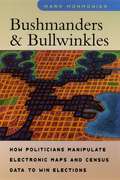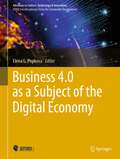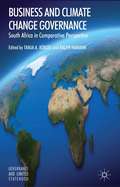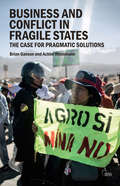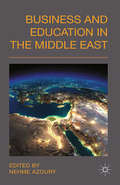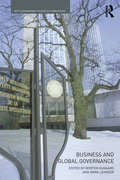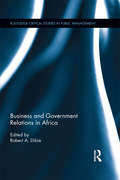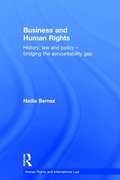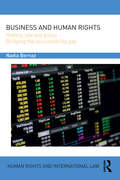- Table View
- List View
Bushmanders and Bullwinkles: How Politicians Manipulate Electronic Maps and Census Data to Win Elections
by Mark MonmonierFor years Mark Monmonier, "a prose stylist of no mean ability or charm" according to the Washington Post, has delighted readers with his insightful understanding of cartography as an art and technology that is both deceptive and revealing. Now he turns his focus to the story of political cartography and the redrawing of congressional districts. His title Bushmanders and Bullwinkles combines gerrymander with the surname of the president who actively tolerated racial gerrymandering and draws attention to the ridiculously shaped congressional districts that evoke the antlers of the moose who shared the cartoon spotlight with Rocky the Flying Squirrel. Written from the perspective of a cartographer rather than a political scientist, Bushmanders and Bullwinkles examines the political tales maps tell when votes and power are at stake. Monmonier shows how redistricting committees carve out favorable election districts for themselves and their allies; how disgruntled politicians use shape to challenge alleged racial gerrymanders; and how geographic information systems can make reapportionment a controversial process with outrageous products. He also explores controversies over the proper roles of natural boundaries, media maps, census enumeration, and ethnic identity. Raising important questions about Supreme Court decisions in regulating redistricting, Monmonier asks if the focus on form rather than function may be little more than a distraction from larger issues like election reform. Characterized by the same wit and clarity as Monmonier's previous books, Bushmanders and Bullwinkles is essential background for understanding what might prove the most contentious political debate of the new decade.
Bushmanders and Bullwinkles: How Politicians Manipulate Electronic Maps and Census Data to Win Elections
by Mark MonmonierFor years Mark Monmonier, "a prose stylist of no mean ability or charm" according to the Washington Post, has delighted readers with his insightful understanding of cartography as an art and technology that is both deceptive and revealing. Now he turns his focus to the story of political cartography and the redrawing of congressional districts. His title Bushmanders and Bullwinkles combines gerrymander with the surname of the president who actively tolerated racial gerrymandering and draws attention to the ridiculously shaped congressional districts that evoke the antlers of the moose who shared the cartoon spotlight with Rocky the Flying Squirrel. Written from the perspective of a cartographer rather than a political scientist, Bushmanders and Bullwinkles examines the political tales maps tell when votes and power are at stake. Monmonier shows how redistricting committees carve out favorable election districts for themselves and their allies; how disgruntled politicians use shape to challenge alleged racial gerrymanders; and how geographic information systems can make reapportionment a controversial process with outrageous products. He also explores controversies over the proper roles of natural boundaries, media maps, census enumeration, and ethnic identity. Raising important questions about Supreme Court decisions in regulating redistricting, Monmonier asks if the focus on form rather than function may be little more than a distraction from larger issues like election reform. Characterized by the same wit and clarity as Monmonier's previous books, Bushmanders and Bullwinkles is essential background for understanding what might prove the most contentious political debate of the new decade.
Bushmanders and Bullwinkles: How Politicians Manipulate Electronic Maps and Census Data to Win Elections
by Mark MonmonierFor years Mark Monmonier, "a prose stylist of no mean ability or charm" according to the Washington Post, has delighted readers with his insightful understanding of cartography as an art and technology that is both deceptive and revealing. Now he turns his focus to the story of political cartography and the redrawing of congressional districts. His title Bushmanders and Bullwinkles combines gerrymander with the surname of the president who actively tolerated racial gerrymandering and draws attention to the ridiculously shaped congressional districts that evoke the antlers of the moose who shared the cartoon spotlight with Rocky the Flying Squirrel. Written from the perspective of a cartographer rather than a political scientist, Bushmanders and Bullwinkles examines the political tales maps tell when votes and power are at stake. Monmonier shows how redistricting committees carve out favorable election districts for themselves and their allies; how disgruntled politicians use shape to challenge alleged racial gerrymanders; and how geographic information systems can make reapportionment a controversial process with outrageous products. He also explores controversies over the proper roles of natural boundaries, media maps, census enumeration, and ethnic identity. Raising important questions about Supreme Court decisions in regulating redistricting, Monmonier asks if the focus on form rather than function may be little more than a distraction from larger issues like election reform. Characterized by the same wit and clarity as Monmonier's previous books, Bushmanders and Bullwinkles is essential background for understanding what might prove the most contentious political debate of the new decade.
Bushmanders and Bullwinkles: How Politicians Manipulate Electronic Maps and Census Data to Win Elections
by Mark MonmonierFor years Mark Monmonier, "a prose stylist of no mean ability or charm" according to the Washington Post, has delighted readers with his insightful understanding of cartography as an art and technology that is both deceptive and revealing. Now he turns his focus to the story of political cartography and the redrawing of congressional districts. His title Bushmanders and Bullwinkles combines gerrymander with the surname of the president who actively tolerated racial gerrymandering and draws attention to the ridiculously shaped congressional districts that evoke the antlers of the moose who shared the cartoon spotlight with Rocky the Flying Squirrel. Written from the perspective of a cartographer rather than a political scientist, Bushmanders and Bullwinkles examines the political tales maps tell when votes and power are at stake. Monmonier shows how redistricting committees carve out favorable election districts for themselves and their allies; how disgruntled politicians use shape to challenge alleged racial gerrymanders; and how geographic information systems can make reapportionment a controversial process with outrageous products. He also explores controversies over the proper roles of natural boundaries, media maps, census enumeration, and ethnic identity. Raising important questions about Supreme Court decisions in regulating redistricting, Monmonier asks if the focus on form rather than function may be little more than a distraction from larger issues like election reform. Characterized by the same wit and clarity as Monmonier's previous books, Bushmanders and Bullwinkles is essential background for understanding what might prove the most contentious political debate of the new decade.
Bushmanders and Bullwinkles: How Politicians Manipulate Electronic Maps and Census Data to Win Elections
by Mark MonmonierFor years Mark Monmonier, "a prose stylist of no mean ability or charm" according to the Washington Post, has delighted readers with his insightful understanding of cartography as an art and technology that is both deceptive and revealing. Now he turns his focus to the story of political cartography and the redrawing of congressional districts. His title Bushmanders and Bullwinkles combines gerrymander with the surname of the president who actively tolerated racial gerrymandering and draws attention to the ridiculously shaped congressional districts that evoke the antlers of the moose who shared the cartoon spotlight with Rocky the Flying Squirrel. Written from the perspective of a cartographer rather than a political scientist, Bushmanders and Bullwinkles examines the political tales maps tell when votes and power are at stake. Monmonier shows how redistricting committees carve out favorable election districts for themselves and their allies; how disgruntled politicians use shape to challenge alleged racial gerrymanders; and how geographic information systems can make reapportionment a controversial process with outrageous products. He also explores controversies over the proper roles of natural boundaries, media maps, census enumeration, and ethnic identity. Raising important questions about Supreme Court decisions in regulating redistricting, Monmonier asks if the focus on form rather than function may be little more than a distraction from larger issues like election reform. Characterized by the same wit and clarity as Monmonier's previous books, Bushmanders and Bullwinkles is essential background for understanding what might prove the most contentious political debate of the new decade.
Bushmanders and Bullwinkles: How Politicians Manipulate Electronic Maps and Census Data to Win Elections
by Mark MonmonierFor years Mark Monmonier, "a prose stylist of no mean ability or charm" according to the Washington Post, has delighted readers with his insightful understanding of cartography as an art and technology that is both deceptive and revealing. Now he turns his focus to the story of political cartography and the redrawing of congressional districts. His title Bushmanders and Bullwinkles combines gerrymander with the surname of the president who actively tolerated racial gerrymandering and draws attention to the ridiculously shaped congressional districts that evoke the antlers of the moose who shared the cartoon spotlight with Rocky the Flying Squirrel. Written from the perspective of a cartographer rather than a political scientist, Bushmanders and Bullwinkles examines the political tales maps tell when votes and power are at stake. Monmonier shows how redistricting committees carve out favorable election districts for themselves and their allies; how disgruntled politicians use shape to challenge alleged racial gerrymanders; and how geographic information systems can make reapportionment a controversial process with outrageous products. He also explores controversies over the proper roles of natural boundaries, media maps, census enumeration, and ethnic identity. Raising important questions about Supreme Court decisions in regulating redistricting, Monmonier asks if the focus on form rather than function may be little more than a distraction from larger issues like election reform. Characterized by the same wit and clarity as Monmonier's previous books, Bushmanders and Bullwinkles is essential background for understanding what might prove the most contentious political debate of the new decade.
Bush's Wars
by Terry H. AndersonFrom journalistic accounts like Fiasco and Imperial Life in the Emerald City to insider memoirs like Jawbreaker and Three Cups of Tea, the books about America's wars in Iraq and Afghanistan could fill a library. But each explores a narrow slice of a whole: two wars launched by a single president as part of a single foreign policy. Now noted historian Terry Anderson examines them together, in a single comprehensive overview. Shortly after the terrorist attacks of September 11, 2001, President George W. Bush told advisor Karl Rove, "I am here for a reason, and this is how we're going to be judged." Anderson provides this judgment in this sweeping, authoritative account of Bush's War on Terror and his twin interventions. He begins with historical surveys of Iraq and Afghanistan-known respectively as "the improbable country" and "the graveyard of empires," and he examines US policies toward those and other nations in the Middle East from the 1970s to 2000. Then Anderson focuses on the Bush Administration, carrying us through such events as the terrorist's attacks of 9/11, the invasion of Afghanistan and the siege of Tora Bora, the "Axis of Evil" speech, the invasion of Iraq and capture of Baghdad, and the eruption of insurgency in Iraq. He ranges from RPGs slamming into Abrams tanks to cabinet meetings, vividly portraying both soldiers in the field and such policymakers as Dick Cheney and Condoleezza Rice. Anderson describes the counter-insurgency strategy embodied by the "surge" in Iraq, and the simultaneous revival of the Taliban. He concludes with an assessment of the prosecution of the wars in the first years of Barack Obama's presidency. Carefully researched and briskly narrated, Bush's Wars provides the single-volume balanced history that we have waited for. This new paperback edition takes the story through the first Obama term, covering our exit from Iraq and the ongoing drawdown in Afghanistan.
Bush's Wars
by Terry H. AndersonFrom journalistic accounts like Fiasco and Imperial Life in the Emerald City to insider memoirs like Jawbreaker and Three Cups of Tea, the books about America's wars in Iraq and Afghanistan could fill a library. But each explores a narrow slice of a whole: two wars launched by a single president as part of a single foreign policy. Now noted historian Terry Anderson examines them together, in a single comprehensive overview. Shortly after the terrorist attacks of September 11, 2001, President George W. Bush told advisor Karl Rove, "I am here for a reason, and this is how we're going to be judged." Anderson provides this judgment in this sweeping, authoritative account of Bush's War on Terror and his twin interventions. He begins with historical surveys of Iraq and Afghanistan-known respectively as "the improbable country" and "the graveyard of empires," and he examines US policies toward those and other nations in the Middle East from the 1970s to 2000. Then Anderson focuses on the Bush Administration, carrying us through such events as the terrorist's attacks of 9/11, the invasion of Afghanistan and the siege of Tora Bora, the "Axis of Evil" speech, the invasion of Iraq and capture of Baghdad, and the eruption of insurgency in Iraq. He ranges from RPGs slamming into Abrams tanks to cabinet meetings, vividly portraying both soldiers in the field and such policymakers as Dick Cheney and Condoleezza Rice. Anderson describes the counter-insurgency strategy embodied by the "surge" in Iraq, and the simultaneous revival of the Taliban. He concludes with an assessment of the prosecution of the wars in the first years of Barack Obama's presidency. Carefully researched and briskly narrated, Bush's Wars provides the single-volume balanced history that we have waited for. This new paperback edition takes the story through the first Obama term, covering our exit from Iraq and the ongoing drawdown in Afghanistan.
Business 4.0 as a Subject of the Digital Economy (Advances in Science, Technology & Innovation)
by Elena G. PopkovaThis book substantiates the transformation processes in the system of modern entrepreneurship in the conditions of formation of Industry 4.0. The authors develop a scientific concept of business 4.0, determine the specific features of business 4.0 and current problems and perspectives of its development in developed and developing markets, study the infrastructural provision of business 4.0 in view of its sectorial specifics, outline the perspectives and recommendations in the sphere of development of business 4.0, and offer the scientific and practical recommendations for state and corporate management.
Business and Climate Change Governance: South Africa in Comparative Perspective (Governance and Limited Statehood)
by Tanja BorzelHow and why do business organisations contribute to climate change governance? The contributors' findings on South Africa, Kenya and Germany demonstrate that business contributions to the mitigation and adaptation to climate change vary significantly.
Business and Conflict in Fragile States: The Case for Pragmatic Solutions (Adelphi series)
by Brian Ganson Achim WennmannLarge-scale investments in fragile states – in Latin America, Africa, the former Soviet Union and Asia – become magnets for conflict, which undermines business, development and security. International policy responds with regulation, state-building and institutional reform, with poor and often perverse results. Caught up in old ways of thinking about conflict and fragility, and an age-old fight over whether multinational corporations are good or bad for peaceful development, it leaves business-related conflicts in fragile states to multiply and fester. Surveying a new strategic landscape of business and conflict, Brian Ganson and Achim Wennmann conclude that neither company shareholders nor advocates for peaceful development need, or should, accept the growing cost of business-related conflict in fragile states. Drawing on decades of experience from mainstream conflict prevention and violence reduction efforts, as well as promising company practice, they show that even acute conflict is manageable when dealt with pragmatically, locally and on its own terms. The analysis and conclusions of this Adelphi book will interest policymakers, business leaders and community advocates alike – all those hoping to mitigate today’s conflicts while helping to reduce fragility and build a firmer foundation for inclusive development.
Business and Conflict in Fragile States: The Case for Pragmatic Solutions (Adelphi series)
by Brian Ganson Achim WennmannLarge-scale investments in fragile states – in Latin America, Africa, the former Soviet Union and Asia – become magnets for conflict, which undermines business, development and security. International policy responds with regulation, state-building and institutional reform, with poor and often perverse results. Caught up in old ways of thinking about conflict and fragility, and an age-old fight over whether multinational corporations are good or bad for peaceful development, it leaves business-related conflicts in fragile states to multiply and fester. Surveying a new strategic landscape of business and conflict, Brian Ganson and Achim Wennmann conclude that neither company shareholders nor advocates for peaceful development need, or should, accept the growing cost of business-related conflict in fragile states. Drawing on decades of experience from mainstream conflict prevention and violence reduction efforts, as well as promising company practice, they show that even acute conflict is manageable when dealt with pragmatically, locally and on its own terms. The analysis and conclusions of this Adelphi book will interest policymakers, business leaders and community advocates alike – all those hoping to mitigate today’s conflicts while helping to reduce fragility and build a firmer foundation for inclusive development.
Business and Education in the Middle East
by Nehme AzouryBusiness and Education in the Middle East brings together academic and business expertise in order to come up with long-term strategies that will have a great effect on the university performance and governance. The book shares experiences and knowledge to explore innovative strategies and plans with a new perspective for the future.
Business and Global Governance (Routledge Studies in Globalisation)
by Morten Ougaard Anna LeanderOver the past two decades, the role of business in global governance has become increasingly topical. Transnational business associations are progressively more visible in international policy debates and in intergovernmental institutions, and there is a heightened attention given to global policy-making in national and international business communities. This text examines and explains the multiple modes of engagement between business and global governance; it presents a variety of theoretical approaches which can be used to analyse them, along with empirical illustrations. Featuring a range of leading US and European scholars, it is divided into three parts that summarize different modes of engagement. Each section is illustrated by two or three studies that represent a distinct theoretical take on the issue with empirical illustrations. The book examines: Business as master and purpose of global governance Business as subject and opponent to global governance Business as partner and facilitator of global governance This book will be of interest to students and scholars of Business Studies, International Relations, International Politics and International Political Economy, as well as for practitioners – in the public and private sector.
Business and Global Governance (Routledge Studies in Globalisation)
by Morten Ougaard Anna LeanderOver the past two decades, the role of business in global governance has become increasingly topical. Transnational business associations are progressively more visible in international policy debates and in intergovernmental institutions, and there is a heightened attention given to global policy-making in national and international business communities. This text examines and explains the multiple modes of engagement between business and global governance; it presents a variety of theoretical approaches which can be used to analyse them, along with empirical illustrations. Featuring a range of leading US and European scholars, it is divided into three parts that summarize different modes of engagement. Each section is illustrated by two or three studies that represent a distinct theoretical take on the issue with empirical illustrations. The book examines: Business as master and purpose of global governance Business as subject and opponent to global governance Business as partner and facilitator of global governance This book will be of interest to students and scholars of Business Studies, International Relations, International Politics and International Political Economy, as well as for practitioners – in the public and private sector.
Business and Governance in South Africa: Racing to the Top? (Governance and Limited Statehood)
by Tanja A. Börzel and Christian R. ThauerThe authors identify conditions under which firms seek higher rather than lower regulation in a context of weak regulatory capacities by engaging in self-regulation or partnering up with the government and/or NGOs. They analyse how firms in the automotive, food, textile, and mining sectors fight environmental pollution and HIV/AIDS.
Business and Government Relations in Africa (Routledge Critical Studies in Public Management)
by Robert A. DibieThis book endeavors to take the conceptualization of the relationship between business, government and development in African countries to a new level. In the twenty-first century, the interests and operations of government and business inevitably intersect all over the African continent. No government, federal or state, can afford to ignore the needs of business. But what are these needs, how does business express its needs to government and what institutions organize government-business relations in African countries? How should government regulate business, or should it choose to let the markets rule? Government and Business Relations in Africa brings together many of sub-Saharan African leading scholars to address these critical questions. Business and Government Relations in Africa examines the key players in the game—federal and state governments and business groups—and the processes that govern the relationships between them. It looks at the regulatory regimes that have an impact on business and provides a number of case studies of the relationships between government and economic development around the African continent, highlighting different processes and practices. It shows the latest state of knowledge on the topic and will be of interest both to students at an advanced level, academics and reflective practitioners. It addresses the topics with regard to business-government relations and will be of interest to researchers, academics, policymakers, and students in the fields of African politics, comparative politics, public policy, business and politics, sustainable development and sustainability, economic development, and managerial economics.
Business and Government Relations in Africa (Routledge Critical Studies in Public Management)
by Robert A. DibieThis book endeavors to take the conceptualization of the relationship between business, government and development in African countries to a new level. In the twenty-first century, the interests and operations of government and business inevitably intersect all over the African continent. No government, federal or state, can afford to ignore the needs of business. But what are these needs, how does business express its needs to government and what institutions organize government-business relations in African countries? How should government regulate business, or should it choose to let the markets rule? Government and Business Relations in Africa brings together many of sub-Saharan African leading scholars to address these critical questions. Business and Government Relations in Africa examines the key players in the game—federal and state governments and business groups—and the processes that govern the relationships between them. It looks at the regulatory regimes that have an impact on business and provides a number of case studies of the relationships between government and economic development around the African continent, highlighting different processes and practices. It shows the latest state of knowledge on the topic and will be of interest both to students at an advanced level, academics and reflective practitioners. It addresses the topics with regard to business-government relations and will be of interest to researchers, academics, policymakers, and students in the fields of African politics, comparative politics, public policy, business and politics, sustainable development and sustainability, economic development, and managerial economics.
Business and Human Rights: History, Law and Policy - Bridging the Accountability Gap
by Nadia BernazBusiness corporations can and do violate human rights all over the world, and they are often not held to account. Emblematic cases and situations such as the state of the Niger Delta and the collapse of the Rana Plaza factory are examples of corporate human rights abuses which are not adequately prevented and remedied. Business and human rights as a field seeks to enhance the accountability of business - companies and businesspeople - in the human rights area, or, to phrase it differently, to bridge the accountability gap. Bridging the accountability gap is to be understood as both setting standards and holding corporations and businesspeople to account if violations occur. Adopting a legal perspective, this book presents the ways in which this dual undertaking has been and could be further carried out in the future, and evaluates the extent to which the various initiatives in the field bridge the corporate accountability gap. It looks at the historical background of the field of business and human rights, and examines salient periods, events and cases. The book then goes on to explore the relevance of international human rights law and international criminal law for global business. International soft law and policy initiatives which have blossomed in recent years are evaluated along with private modes of regulation. The book also examines how domestic law, especially the domestic law of multinational companies' home countries, can be used to prevent and redress corporate related human rights violations. 9781138683006 / 9781315626055
Business and Human Rights: History, Law and Policy - Bridging the Accountability Gap (PDF)
by Nadia BernazBusiness corporations can and do violate human rights all over the world, and they are often not held to account. Emblematic cases and situations such as the state of the Niger Delta and the collapse of the Rana Plaza factory are examples of corporate human rights abuses which are not adequately prevented and remedied. Business and human rights as a field seeks to enhance the accountability of business - companies and business people - in the human rights area, or, to phrase it differently, to bridge the accountability gap. Bridging the accountability gap is to be understood as both setting standards and holding corporations and business people to account if violations occur. Adopting a legal perspective, this book presents the ways in which this dual undertaking has been and could be further carried out in the future, and evaluates the extent to which the various initiatives in the field bridge the corporate accountability gap. It looks at the historical background of the field of business and human rights, and examines salient periods, events and cases. The book then goes on to explore the relevance of international human rights law and international criminal law for global business. International soft law and policy initiatives which have blossomed in recent years are evaluated along with private modes of regulation. The book also examines how domestic law, especially the domestic law of multinational companies' home countries, can be used to prevent and redress corporate related human rights violations. 9781138683006 / 9781315626055
Business and Human Rights: History, Law and Policy - Bridging the Accountability Gap (Human Rights and International Law)
by Nadia BernazBusiness corporations can and do violate human rights all over the world, and they are often not held to account. Emblematic cases and situations such as the state of the Niger Delta and the collapse of the Rana Plaza factory are examples of corporate human rights abuses which are not adequately prevented and remedied. Business and human rights as a field seeks to enhance the accountability of business – companies and businesspeople – in the human rights area, or, to phrase it differently, to bridge the accountability gap. Bridging the accountability gap is to be understood as both setting standards and holding corporations and businesspeople to account if violations occur. Adopting a legal perspective, this book presents the ways in which this dual undertaking has been and could be further carried out in the future, and evaluates the extent to which the various initiatives in the field bridge the corporate accountability gap. It looks at the historical background of the field of business and human rights, and examines salient periods, events and cases. The book then goes on to explore the relevance of international human rights law and international criminal law for global business. International soft law and policy initiatives which have blossomed in recent years are evaluated along with private modes of regulation. The book also examines how domestic law, especially the domestic law of multinational companies’ home countries, can be used to prevent and redress corporate related human rights violations.
Business and Human Rights: History, Law and Policy - Bridging the Accountability Gap (Human Rights and International Law)
by Nadia BernazBusiness corporations can and do violate human rights all over the world, and they are often not held to account. Emblematic cases and situations such as the state of the Niger Delta and the collapse of the Rana Plaza factory are examples of corporate human rights abuses which are not adequately prevented and remedied. Business and human rights as a field seeks to enhance the accountability of business – companies and businesspeople – in the human rights area, or, to phrase it differently, to bridge the accountability gap. Bridging the accountability gap is to be understood as both setting standards and holding corporations and businesspeople to account if violations occur. Adopting a legal perspective, this book presents the ways in which this dual undertaking has been and could be further carried out in the future, and evaluates the extent to which the various initiatives in the field bridge the corporate accountability gap. It looks at the historical background of the field of business and human rights, and examines salient periods, events and cases. The book then goes on to explore the relevance of international human rights law and international criminal law for global business. International soft law and policy initiatives which have blossomed in recent years are evaluated along with private modes of regulation. The book also examines how domestic law, especially the domestic law of multinational companies’ home countries, can be used to prevent and redress corporate related human rights violations.
Business and Human Rights: From Principles to Practice
by Nolan Justine Dorothée Baumann-PaulyIn a global economy, multinational companies often operate in jurisdictions where governments are either unable or unwilling to uphold even the basic human rights of their citizens. The expectation that companies respect human rights in their own operations and in their business relationships is now a business reality that corporations need to respond to. Business and Human Rights: From Principles to Practiceis the first comprehensive and interdisciplinary textbook that addresses these issues. It examines the regulatory framework that grounds the business and human rights debate and highlights the business and legal challenges faced by companies and stakeholders in improving respect for human rights, exploring such topics as: the regulatory framework that grounds the business and human rights debate challenges faced by companies and stakeholders in improving human rights industry-specific human rights standards current mechanisms to hold corporations to account future challenges for business and human rights With supporting case studies throughout, this text provides an overview of current themes in the field and guidance on practical implementation, demonstrating that a thorough understanding of the human rights challenges faced by business is now vital in any business context. 9781138833586 9781315735429
Business and Human Rights: From Principles to Practice (PDF)
by Nolan Justine Dorothée Baumann-PaulyIn a global economy, multinational companies often operate in jurisdictions where governments are either unable or unwilling to uphold even the basic human rights of their citizens. The expectation that companies respect human rights in their own operations and in their business relationships is now a business reality that corporations need to respond to. Business and Human Rights: From Principles to Practiceis the first comprehensive and interdisciplinary textbook that addresses these issues. It examines the regulatory framework that grounds the business and human rights debate and highlights the business and legal challenges faced by companies and stakeholders in improving respect for human rights, exploring such topics as: the regulatory framework that grounds the business and human rights debate challenges faced by companies and stakeholders in improving human rights industry-specific human rights standards current mechanisms to hold corporations to account future challenges for business and human rights With supporting case studies throughout, this text provides an overview of current themes in the field and guidance on practical implementation, demonstrating that a thorough understanding of the human rights challenges faced by business is now vital in any business context. Business and Human Rights: From Principles to Practice Dorothée Baumann-Pauly Nolan Justine Download... What Format Should I Choose? Add to Reading List Add Brief Synopsis: In a global economy, multinational companies often operate in jurisdictions where governments are either unable or unwilling to uphold even the basic human rights of their citizens. Long Synopsis: In a global economy, multinational companies often operate in jurisdictions where governments are either unable or unwilling to uphold even the basic human rights of their citizens. The expectation that companies respect human rights in their own operations and in their business relationships is now a business reality that corporations need to respond to. Business and Human Rights: From Principles to Practiceis the first comprehensive and interdisciplinary textbook that addresses these issues. It examines the regulatory framework that grounds the business and human rights debate and highlights the business and legal challenges faced by companies and stakeholders in improving respect for human rights, exploring such topics as: the regulatory framework that grounds the business and human rights debate challenges faced by companies and stakeholders in improving human rights industry-specific human rights standards current mechanisms to hold corporations to account future challenges for business and human rights With supporting case studies throughout, this text provides an overview of current themes in the field and guidance on practical implementation, demonstrating that a thorough understanding of the human rights challenges faced by business is now vital in any business context. 9781138833586 9781315735429
Business and Human Rights: The Obligations of the European Home States
by Dalia PalomboThis book analyses the accountability of European home States for their failure to secure the human rights of victims from host States against transnational enterprises. It argues for a reconfiguration of the relationship between multinational enterprises and individuals, both of which have been profoundly changed by globalisation. Enterprises are now supranational entities with numerous affiliates all over the world. Likewise, individuals are increasingly part of a global community. Despite this, the relationship between the two is deregulated. Addressing this gap, this study proposes an innovative business and human rights litigation strategy. Human rights advocates could file a test case against a European home State, at the European Court of Human Rights, for its failure to secure the rights of victims vis-à-vis European multinational enterprises. The book illustrates why such a strategy is needed, and points to the lack of effective legal remedies against European multinationals. The goal is to empower victims from developing countries against European States which are failing to hold multinational enterprises accountable for human rights abuses.
